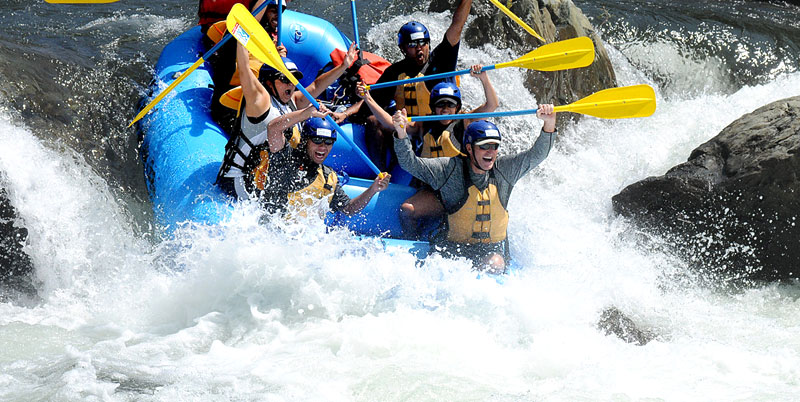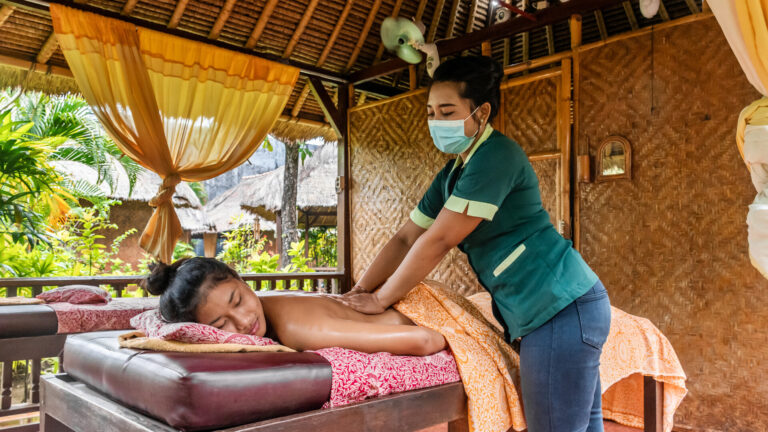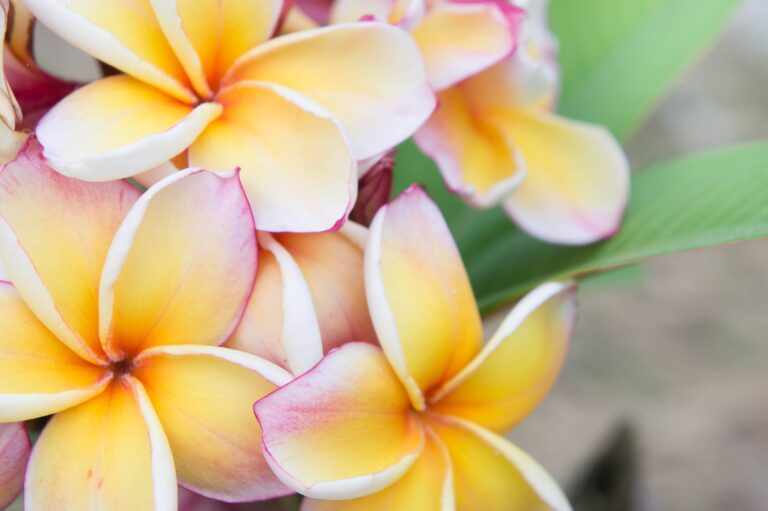If you’re considering a Bali rafting tour and an exhilarating rafting adventure, you should take a few minutes to read our complete guide to Bali river rafting.
We’ll explain where you can go, how to stay safe in Bali’s rivers and how to book the most cost-effective and enjoyable tours.
Where To Go Bali River Rafting?
There are three main locations for a Bali rafting tour or river rafting adventure. The Ayung River, the Telaga Waja River, and the Melangit River.
They each have advantages and disadvantages, and it’s important to understand which area offers what kind of rafting before you book a rafting tour.
Ayung River Rafting
The Ayung River rafting course runs for about 12 kilometres (7 miles) through the local terrain. You can see rock cliffs, wondrous waterfalls, lush rice fields and more as you follow the river.
It’s one of the most popular destinations for people who are new to rafting or families seeking a thrilling rafting tour that can cater to people of all ages.
The water is calm for most of the course, and there are only 2 to 3 sections of rapids on the Ayung River.
That makes the Ayung River an easy(ish) way to enjoy rafting in Bali without having to develop top-notch white river rafting skills.
It takes about 90 minutes to run the course at the Ayung River. However, you should be aware that to get to the setting-off point, you will need to walk down 500 stairs!
The Ayung River is also very close to Ubud, where many people looking to join a rafting tour will be staying. Most rafting operators have a representative office in Ubud, too.
While weather conditions can, of course, affect the intensity of rapids on the Ayung River, typically, they are no more than Class ii or Class iii on this river. That means they have been rated for newbies to the sport.
Interestingly, the Ayung River is the longest in Bali.
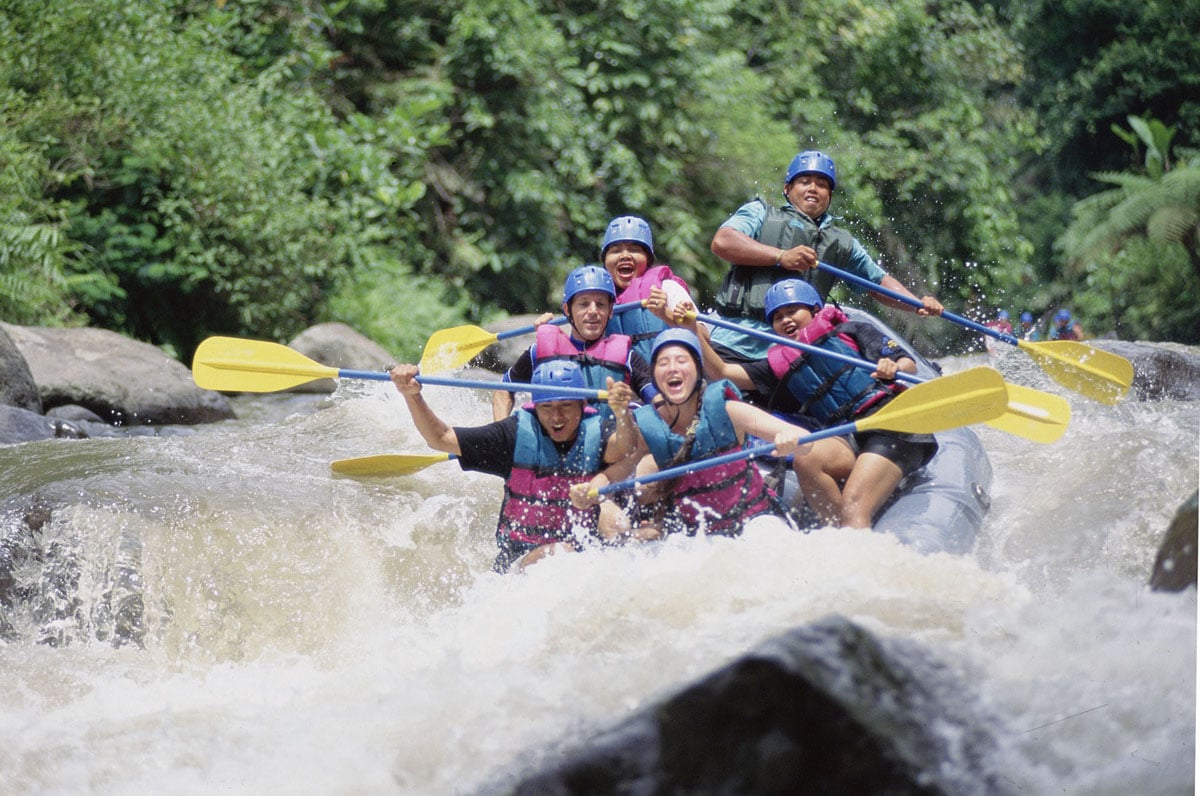
Telaga Waja River Rafting
If you want to turn the volume up a notch, then Telaga Waja River rafting is a much more intense experience.
The waters of the Telaga Waja River have far more rapids than on The Ayung, and you should have some experience of white water rafting if you intend to tackle this course.
On one section of the course, you will have to drop down a waterfall and descend a total of about four meters! Your whole journey here is about 16 kilometres (10 miles), and it takes about 2 1/2 hours from start to finish.
This can be terrifying and leave your heart beating faster for a few minutes afterwards.
The end point is near the village of Sidemen, which is a lovely place to visit and take some photos of traditional Balinese life.
The rapids on this stretch of the Telaga Waja River are rated at Class iii to Class iv most of the time, and that means they are intermediate level.
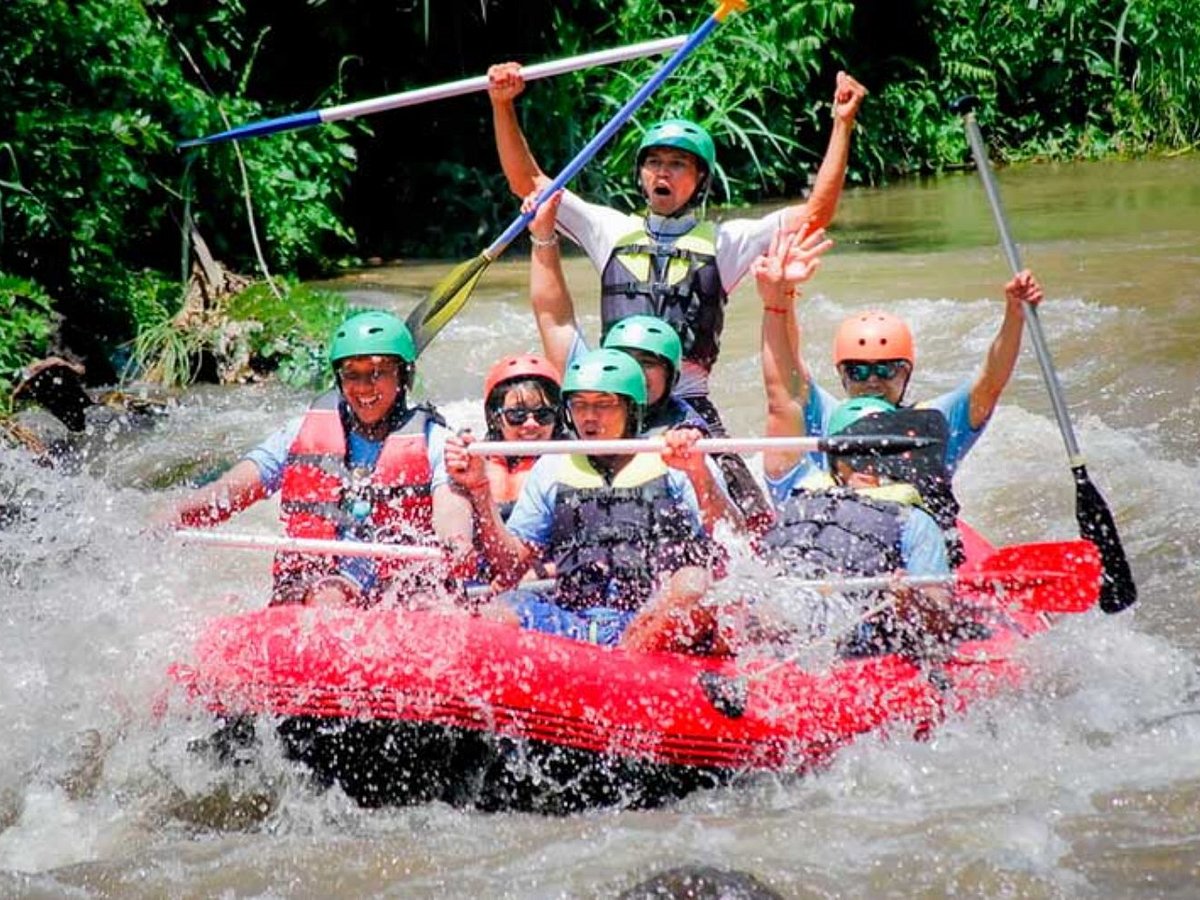
Melangit River Rafting
The Melangit River is even more challenging than Telaga Waja River rafting, and it’s certainly the toughest rafting in Bali.
The river is absolutely packed with rapids, and you will need to keep your wits about you at all times.
However, if you’re up to the challenge, you’re going to love taking on the Melangit River. It’s a pure adrenaline rush.
There are no crowds here, just a beautiful, unspoiled jungle and the chance to see a side of Bali that most people will never know exists.
This is why Bali island has so often been called a paradise island by visitors. The natural beauty of the lush rainforests and main rivers is truly as spectacular as the beaches and ocean.
Rapids here are usually rated as class IV and are more challenging than on the Telaga Waja River. It’s definitely only for some beginners.
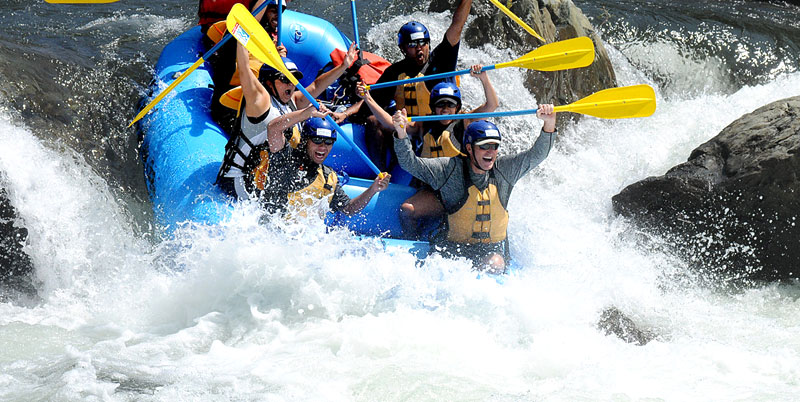
How To Prepare For A White Water Rafting Bali Tour
You don’t need to put in a huge amount of preparation to enjoy river rafting in Bali experience.
That’s because the tour company will do most of the hard work for you, but you do need to bring a few things to have the best time of your rafting experience, and there are some things you should know before you go rafting in Bali.
What To Bring?
You should ensure that you have:
- A change of clothes – it might be hot in Bali, but it’s also quite humid, and wandering around in wet clothes is a little fun. There are usually shower facilities at the end of the tour for you to clean up, too.
- Waterproof suntan lotion – you don’t want to get burned, and if your sun protection isn’t waterproof, it’s going to come off.
- Waterproof bag – only pack a little in this, but if you want to take anything in the raft with you, it will come in handy.
- Money – it goes without saying that you don’t need to pay for rafting equipment or your guide if you’ve booked and paid for a tour. But you might want a meal or some drinks.
- Running or hiking shoes – flip flops might sound ideal, but if you’re climbing rocks, they have no grip and may come off easily in rapids, too.
If you have any clothing that dries very quickly, you should wear that while you raft as it can be more comfortable.
About Your Health
White water rafting is always conducted under the watchful eye of a professional guide, but you still have to steer your kayak yourself.
You will need to row for a fairly long period, and thus, it’s a good idea to have some basic stamina and strength. You will also need reasonable reflexes to stay out of trouble in the rapids.
If you’re suffering from a chronic debilitating health condition or are pregnant, you should only get involved with this kind of rafting after you’ve spoken to a medical professional.
Even Ayung River rafting can be a bit much if you have a weak heart.
About Insurance For Your River Rafting
Your travel insurance policy excludes river rafting from its coverage, which means you will be relying on the tour operator’s insurance.
They will have insurance that covers you in the event of injury or accident, and they may pay a benefit in the event of someone’s death (you are very unlikely to die on a river in Bali). Still, it will not cover any valuables you bring with you.
If you want to take your smartphone or camera on the kayak with you, make sure they are stowed safely and in a waterproof container.
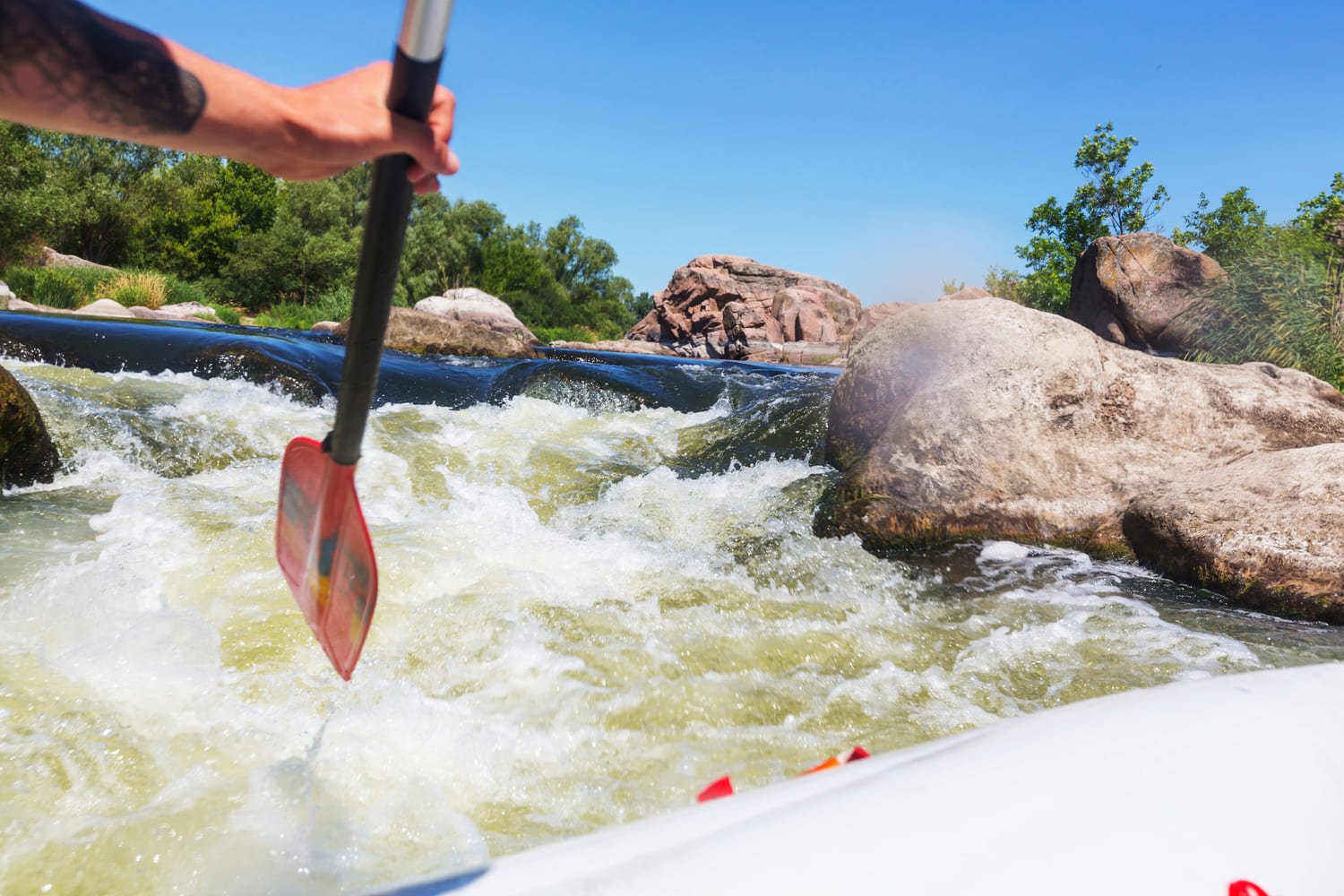
Potential Cancellation & Refunds
Sometimes, the weather in Bali is not conducive to safely spending time on the water and even Ayung River Rafting can become dangerous in a torrential downpour.
In these circumstances, you will be offered the opportunity to rebook but you may not be allowed to cancel and get a refund.
You should make sure that if a refund is required, if you can’t go rafting, that your rafting tour will provide one before you book a rafting tour.
How To Stay Safe While River Rafting
One thing you may not know is that you are not required to be able to swim to go white water rafting. This is particularly true in the Ayung river rafting experiences.
As long as you follow the instructions below, you will be safe
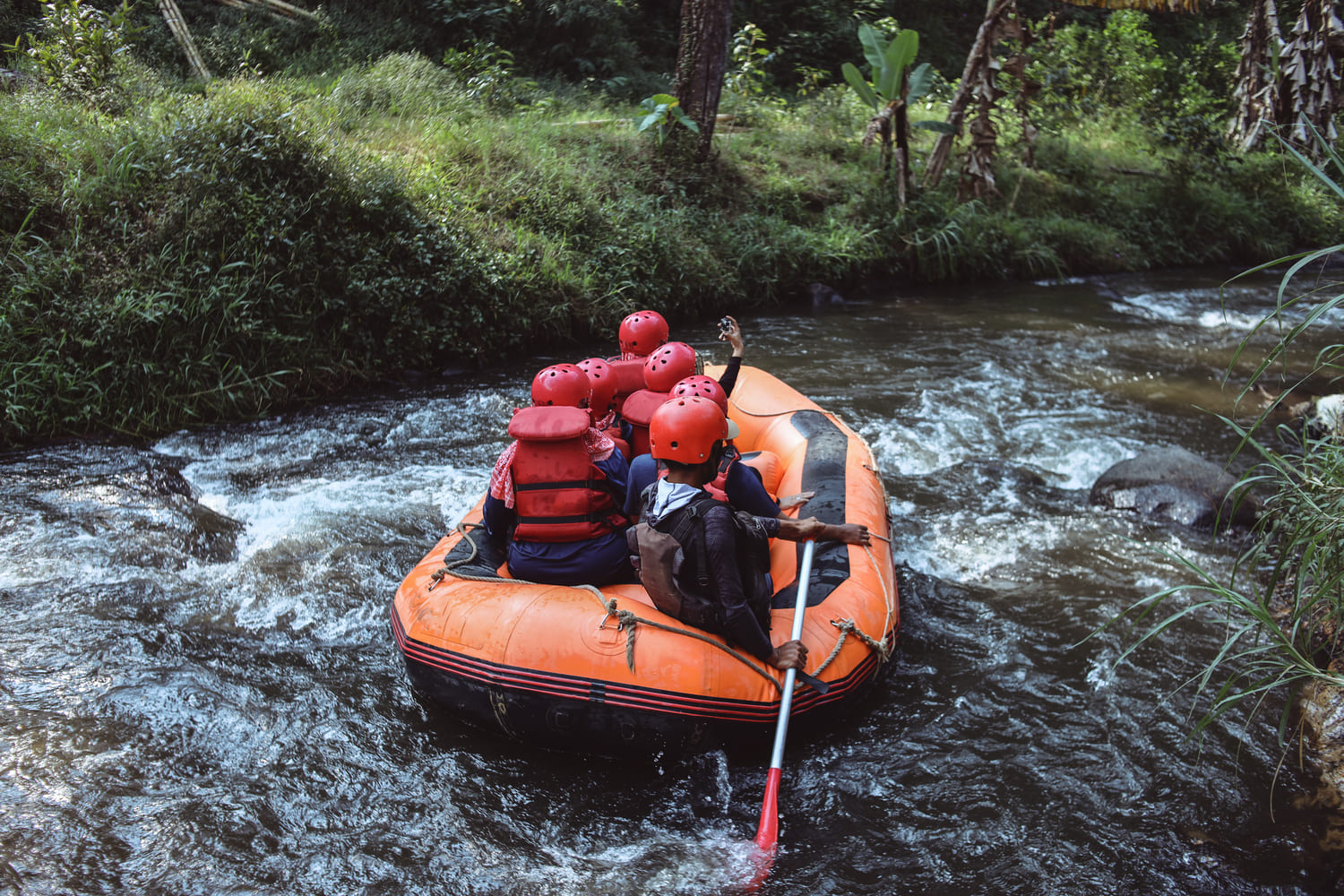
Know Your Difficulty Classification
It would help if you only tackled rapids that are suited to your difficulty level. There is an international scale for the classification of rivers for rafting.
They are ranked from Class I to Class VI. Class I is the safest. Class VI should only be tackled by the most experienced of rafters.
None of Bali’s rivers are rated at Class V or VI under normal circumstances, but rain can change this rating at a moment’s notice.
Use The Protective Gear
You must use the protective gear you are supplied with while you are in your kayak.
That means ensuring you wear your helmet and your life jacket and that they have both been fitted properly.
You will float if you fall out of your kayak as long as you have these things, and the helmet will prevent you from damaging your head on any rocks you float past.
Rafting With Children
Rafting with children in Bali is a brilliant idea, and they can easily tackle the Ayung River and even the Telaga Waja River rafting if they’re a bit older.
Children under the age of 7 should not raft, however, as they are unlikely to have the strength and stamina to stay safe in the event of an accident.
You must take charge of your children’s safety equipment, though, and ensure that they are wearing fitting life jackets and helmets.
Please make sure they are familiar with any safety rules that are laid down by the professional tour guides.
You’ll also want to attend to their sunscreen.
We recommend you bring snacks and drinks if you bring children with you too.
The tour will probably supply some, but they may not like them, or they may want more than the operator supplies.
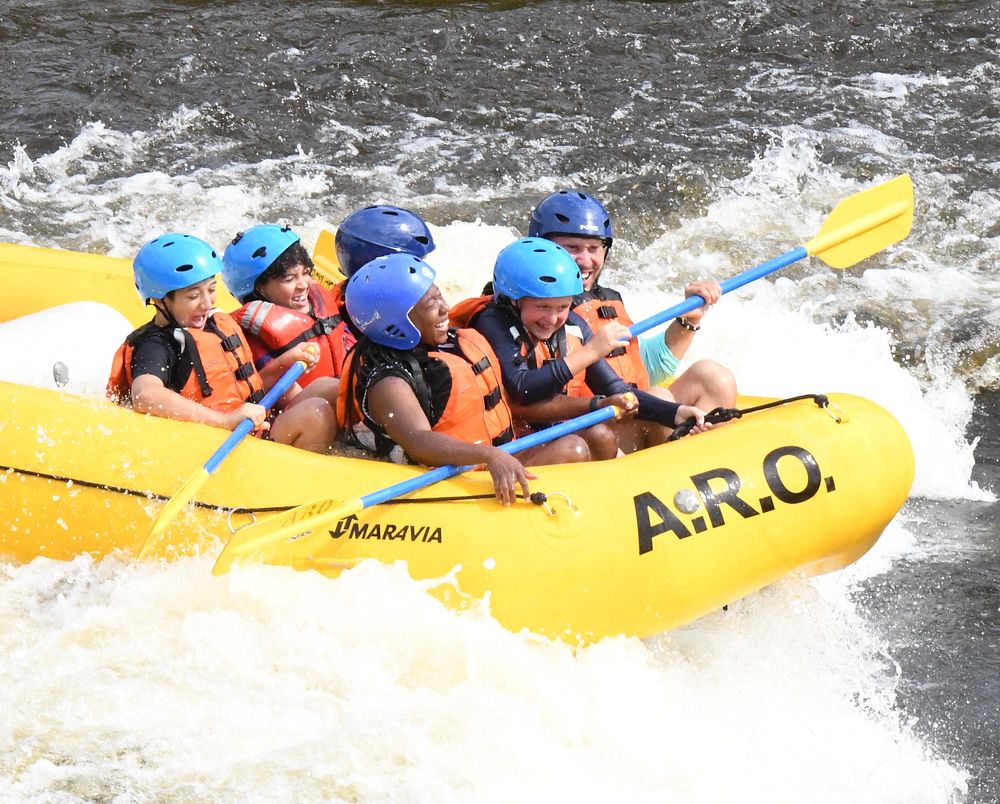
Know Your Difficulty Classification
You should only tackle rapids that are suited to your difficulty level. There is an international scale for the classification of rivers for rafting.
They are ranked from Class I to Class VI. Class I is the safest. Class VI should only be tackled by the most experienced of rafters.
None of Bali’s rivers are rated at Class V or VI under normal circumstances, but rain can change this rating at a moment’s notice.
Use The Protective Gear
You must use the protective gear you are supplied with while you are in your kayak.
That means ensuring you wear your helmet and your life jacket and that they have both been fitted properly.
You will float if you fall out of your kayak as long as you have these things and the helmet will prevent you from damaging your head on any rocks you float past.
Rafting With Children
Rafting with children in Bali is a brilliant idea and they can easily tackle the Ayung River and even the Telaga Waja River rafting if they’re a bit older.
Children under the age of 7 should not raft, however, as they are unlikely to have the strength and stamina to stay safe in the event of an accident.
You must take charge of your children’s safety equipment though and ensure that they are wearing fitting life jackets and helmets.
Make sure they are familiar with any safety rules that are laid down by the professional tour guides.
You’ll probably also want to attend to their sunscreen.
We recommend you bring snacks and drinks if you bring children with you too.
The tour will probably supply some but they may not like them or they may want more than the operator supplies.
When Is The Best Time For Rafting In Bali?
It depends on how much of a challenge you’re looking for. In the wet season, things can get a lot more intense out on the river.
Even Telaga Waja River rafting can become the sort of thing that a professional kayaker might flinch at.
In the dry season, you’re going to find things are usually a lot calmer (though it does rain in this season too at times).
Talk to the tour operator before you leave for the day to get a feel for the actual conditions of your chosen river.
FAQs
Is It Safe To Do White Water Rafting In Bali?
Yes, white water rafting in Bali is generally very safe.
The rafting operators are good at their jobs and the weather and river conditions mean you don’t need that much rafting experience to have a good time.
How Much Does White Water Rafting Cost In Bali?
It depends on the size of the group you want to go with, any important aspects of your trip that must be accommodated, the skills of the highly professional team that runs the tour, which river you want to go white water rafting in, etc.
However, group travellers can get the price down to as low as 400,000 IDR for some trips and solo travellers might need to pay substantially more.
Is There A Weight Limit For White Water Rafting In Bali?
There is no weight limit for white water rafting in Bali. However, you will need to be able to fit in the kayak, which won’t be a problem for most people.
What Grade Are The Rapids In Bali?
It depends on where you go but Ayung Rafting tends to be II-III, Telaga Waja Rafting tends to be III-IV and Melangit Rafting tends to be IV.
However, be aware that the grade of white water rafting depends on weather conditions and these numbers will go up in the pouring rain.
Final Thoughts On Whitewater Rafting in Bali
White water rafting in Bali is an incredible experience. You can commune with Bali nature and the natural beauty of the rainforest and river environment is really special.
The breathtaking views will stay with you for a lifetime.
You don’t have to be an adrenaline junkie to appreciate this fun water sports activity, just opt for the Ayung rafting experience and you’ll have a good time.
If you want something a bit more exciting go with the Telaga Waja River or even the Melangit. Have fun!
Share this entry

